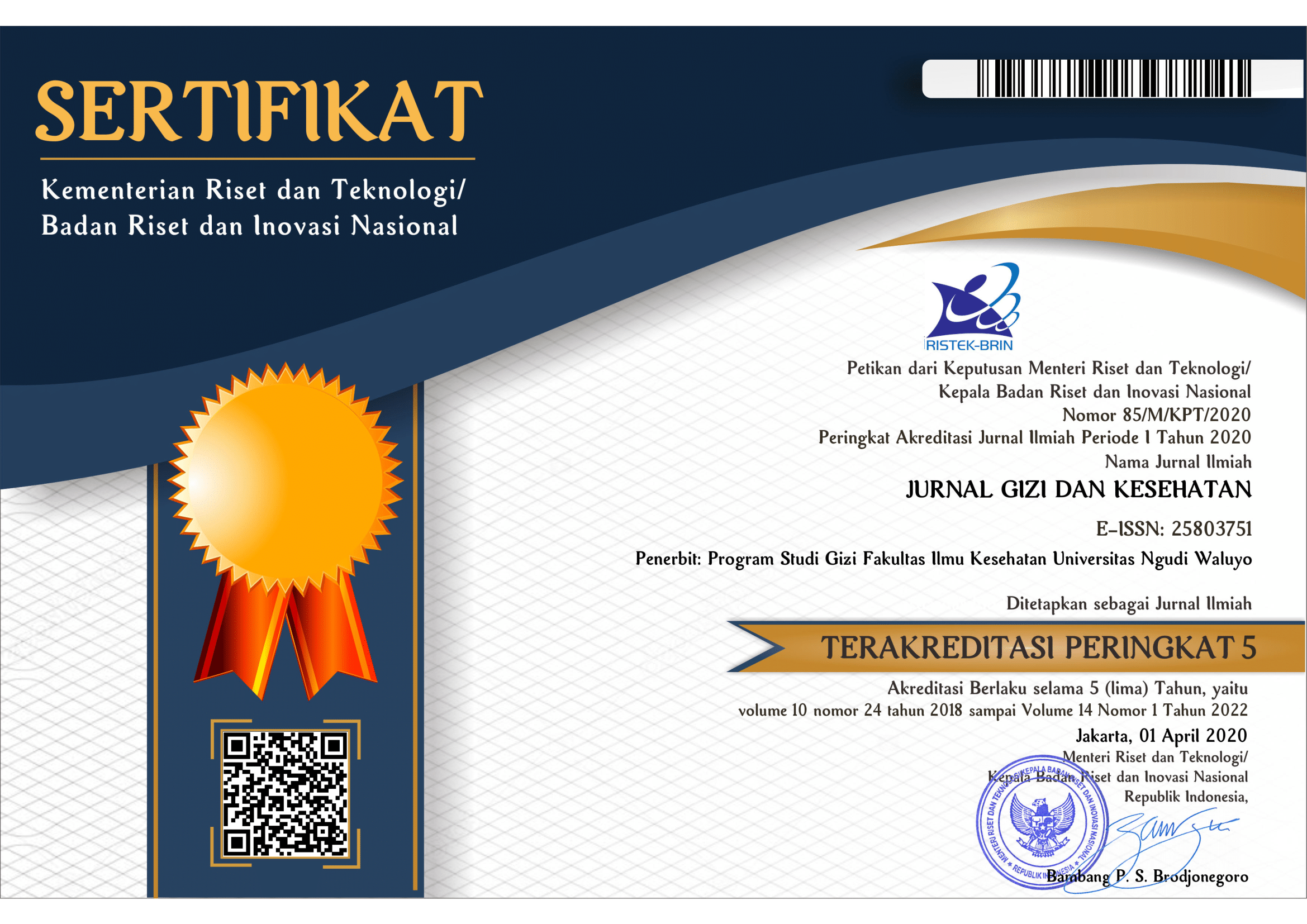PENGARUH MOBILISASI TERHADAP PROSES PENYEMBUHAN LUKA POST OPERASI BENIGNA PROSTAT HIPERPLASIA DI RUANG PERAWATAN BEDAH RSU dr. SLAMET GARUT
INFLUENCE OF MOBILIZATION TO THE POSTOPERATIVE WOUND HEALING PROCESS OF BENIGNA PROSTAT HIPERPLASIA SURGERY IN THE SURGICAL TREATMENT ROOM RSU dr.SLAMET GARUT
DOI:
https://doi.org/10.35473/jgk.v10i23.45Keywords:
Mobilisasi, Luka Post Operasi, Benigna Prostat HiperplasiaAbstract
Background: Benign Prostatic Hyperplasia (BPH) is a condition in which the periurethral glands present in the prostate area develop hyperplasia and the enlargement process occurs slowly. This pathological condition can be experienced by about 70% of men over the age of 50 years and tread old age. This number will increase to 80% in men over the age of 80 years. With clinical manifestations of increased urinary frequency, frequent nighttime urination, urinary urge, decreased urine volume, impaired urine flow, dripping at the end of urination, urinary retention (Brunner and Suddarth, 2002). Patient surgery with diagnosis Benign Prostate Hyperplasia (BPH) in dr. Slamet Garut reached285 people (about 14% of general surgery). Surgical action is a tense experience for some patients, this is due to lack of knowledge about treatment actions and medical action after surgery.
Objective: To know the effect of mobilization on post-surgical wound healing process of BPH in surgical treatment room of Dr dr, Slamet Garut.
Method:The type of research used in this study is quasi experiments, ie experiments that have not or do not have the characteristics of the actual experimental design, because the variables that should be controlled and manipulated by design is one group pre test and post test. In this study, researchers conducted a treatment in the form of mobilization of independent variables, then measured the effects or effects of mobilization on the dependent variable (Notoatmodjo, 2005).
Results: The patient's wound prior to the mobilization had an average score of 2.28 and showed that most of the respondents, the wound healing conditions were in classification 2 were wound / bleed, inflammation, no pus and almost half of the respondents healing wounds in classification 3 wounds are still wet / bleeding, no inflammation and no pus. The condition of the wounded patient after the mobilization had an average score of 4.31 scale and showed more than most of the respondents wound healing conditions were in classification 5 ie wound dry, no inflammation and no pus, then a small part of the respondents are in the classification 4 ie clean wound, there are still signs of inflammation, but there is nopus.
Conclusion: There is an effect of mobilization on post-surgical wound healing process of BPH in surgical treatment room RSU dr Slamet Garut
Abstrak :
Latar Belakang: Benigna Prostatic Hyperplasia (BPH) adalah suatu keadaan dimana kelenjar periuretral yang terdapat di area prostat mengalami hyperplasia dan proses pembesarannya terjadi secara perlahan-lahan. Kondisi patologis ini dapat dialami oleh sekitar 70% pria diatas usia 50 tahun dan menapak usia lanjut. Angka ini akan meningkat hingga 80% pada pria diatas usia 80 tahun. Dengan manifestasi klinis peningkatan frekwensi berkemih, sering berkemih malam hari, dorongan ingin berkemih, volume urin menurun, aliran urin tidak lancar, menetes pada akhir berkemih, retensi urin ( Brunner dan Suddarth, 2002 ). Operasi pasien dengan diagnosa Benigna Prostat Hiperplasia (BPH) di Rumah Sakit umum dr. Slamet Garut mencapai 285 orang (sekitar 14 % dari operasi bedah umum). Tindakan pembedahan merupakan pengalaman menegangkan bagi sebagian pasien, hal ini dikarenakan kurang pengetahuan mengenai tindakan perawatan maupun tindakan medis setelah dilakukan pembedahan.
Tujuan: Mengetahui pengaruh mobilisasi terhadap proses penyembuhan luka post operasi BPH di ruang perawatan bedah RSU dr,Slamet Garut.
Metode: Jenis penelitian yang digunakan dalam penelitian ini adalah quasi eksperimen, yaitu eksperimen yang belum atau tidak memiliki ciri-ciri rancangan eksperimen yang sebenarnya, dikarenakan variabel-variabel yang seharusnya dikontrol dan dimanipulasi dengan desainnya adalah one group pre test dan post test. Dalam penelitian ini, peneliti melakukan suatu perlakuan berupa mobilisasi terhadap variabel independen, kemudian mengukur akibat atau pengaruh mobilisasi tersebut pada variabel dependen (Notoatmodjo, 2005).
Hasil: Keadaan luka pasien sebelum dilakukan mobilisasi memiliki nilai rata-rata skala 2,28 dan menunjukkan bahwa sebagian besar responden, kondisi penyembuhan lukanya berada pada klasifikasi 2 yaitu luka masih basah /berdarah, ada radang, tidak ada pus dan hampir setengahnya dari responden kondisi penyembuhan lukanya pada klasifikasi 3 yaitu luka masih basah/berdarah, tidak ada radang dan tidak ada pus. Keadaan luka pasien setelah dilakukan mobilisasi memiliki nilai rata-rata skala 4,31 dan menunjukkan lebih dari sebagian besar responden kondisi penyembuhan lukanya berada pada klasifikasi 5 yaitu luka kering, tidak ada radang dan tidak ada pus, kemudian sebagian kecil dari responden berada pada klasifikasi 4 yaitu luka bersih, masih terdapat tanda-tanda radang,tetapi tidak ada pus.
Simpulan: Terdapat pengaruh mobilisasi terhadap proses penyembuhan luka post operasi BPH di ruang perawatan bedah RSU dr Slamet Garut
Downloads
References
Arikunto, Suharsimi. 2010. Prosedur Penelitian Suatu Pendekatan Praktik. Edisi Revisi. Jakarta: PT Rineka Cipta.
Brunner & Suddarth. (2001). Buku Ajar Keperawatan Medikal-Bedah. Jakarta: EGC
Danim, S. 2003. Riset Keperawatan. Jakarta: EGC
Dempsey, P.A. (2002). Riset Keperawatan Buku Ajar dan Latihan, Edisi 4. Jakarta: EGC.
Hidayat. (2007). Pengantar Konsep Dasar Keperawatan. Jakarta: Salemba medika.
Nana Wijayana. 2005. Ilmu Penyakit Bedah. Jakarta. Abadi Tegal
Notoatmodjo, Soekidjo. 2005. Metodologi Penelitian Kesehatan. Edisi Revisi Jakarta : PT Rineka Cipta
Notoatmodjo, Soekidjo. 2010. Metodologi Penelitian Kesehatan. Edisi Revisi Jakarta : PT Rineka Cipta
Setiadi. (2007). Riset Keperawatan. Yogyakarta: Graha ilmu
Sudjana. (2004). Metode Statistik. Edisi 3. Bandung: Tarsito.










